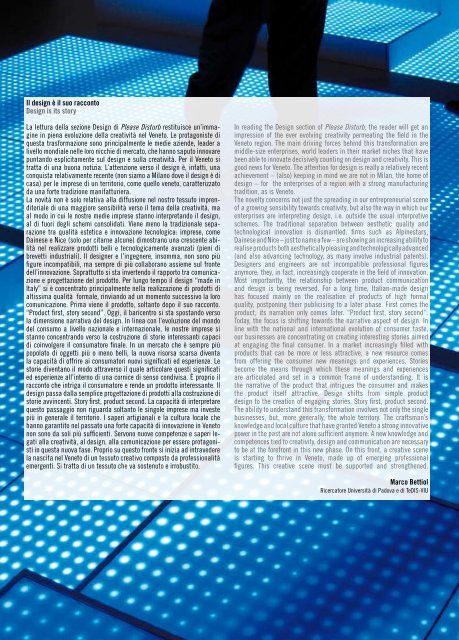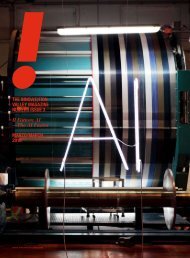PLEASE DISTURB - Fuori Biennale
PLEASE DISTURB - Fuori Biennale
PLEASE DISTURB - Fuori Biennale
Create successful ePaper yourself
Turn your PDF publications into a flip-book with our unique Google optimized e-Paper software.
il design è il suo racconto<br />
design is its story<br />
La lettura della sezione Design di Please Disturb restituisce un’immagine<br />
in piena evoluzione della creatività nel Veneto. Le protagoniste di<br />
questa trasformazione sono principalmente le medie aziende, leader a<br />
livello mondiale nelle loro nicchie di mercato, che hanno saputo innovare<br />
puntando esplicitamente sul design e sulla creatività. Per il Veneto si<br />
tratta di una buona notizia. L’attenzione verso il design è, infatti, una<br />
conquista relativamente recente (non siamo a Milano dove il design è di<br />
casa) per le imprese di un territorio, come quello veneto, caratterizzato<br />
da una forte tradizione manifatturiera.<br />
La novità non è solo relativa alla diffusione nel nostro tessuto imprenditoriale<br />
di una maggiore sensibilità verso il tema della creatività, ma<br />
al modo in cui le nostre medie imprese stanno interpretando il design,<br />
al di fuori degli schemi consolidati. Viene meno la tradizionale separazione<br />
tra qualità estetica e innovazione tecnologica: imprese, come<br />
Dainese e Nice (solo per citarne alcune) dimostrano una crescente abilità<br />
nel realizzare prodotti belli e tecnologicamente avanzati (pieni di<br />
brevetti industriali). Il designer e l’ingegnere, insomma, non sono più<br />
figure incompatibili, ma sempre di più collaborano assieme sul fronte<br />
dell’innovazione. Soprattutto si sta invertendo il rapporto tra comunicazione<br />
e progettazione del prodotto. Per lungo tempo il design “made in<br />
Italy” si è concentrato principalmente nella realizzazione di prodotti di<br />
altissima qualità formale, rinviando ad un momento successivo la loro<br />
comunicazione. Prima viene il prodotto, soltanto dopo il suo racconto.<br />
“Product first, story second”. Oggi, il baricentro si sta spostando verso<br />
la dimensione narrativa del design. In linea con l’evoluzione del mondo<br />
del consumo a livello nazionale e internazionale, le nostre imprese si<br />
stanno concentrando verso la costruzione di storie interessanti capaci<br />
di coinvolgere il consumatore finale. In un mercato che è sempre più<br />
popolato di oggetti più o meno belli, la nuova risorsa scarsa diventa<br />
la capacità di offrire ai consumatori nuovi significati ed esperienze. Le<br />
storie diventano il modo attraverso il quale articolare questi significati<br />
ed esperienze all’interno di una cornice di senso condivisa. È proprio il<br />
racconto che intriga il consumatore e rende un prodotto interessante. Il<br />
design passa dalla semplice progettazione di prodotti alla costruzione di<br />
storie avvincenti. Story first, product second. La capacità di interpretare<br />
questo passaggio non riguarda soltanto le singole imprese ma investe<br />
più in generale il territorio. I saperi artigianali e la cultura locale che<br />
hanno garantito nel passato una forte capacità di innovazione in Veneto<br />
non sono da soli più sufficienti. Servono nuove competenze e saperi legati<br />
alla creatività, al design, alla comunicazione per essere protagonisti<br />
in questa nuova fase. Proprio su questo fronte si inizia ad intravedere<br />
la nascita nel Veneto di un tessuto creativo composto da professionalità<br />
emergenti. Si tratta di un tessuto che va sostenuto e irrobustito.<br />
8<br />
In reading the Design section of Please Disturb, the reader will get an<br />
impression of the ever evolving creativity permeating the field in the<br />
Veneto region. The main driving forces behind this transformation are<br />
middle-size enterprises, world leaders in their market niches that have<br />
been able to innovate decisively counting on design and creativity. This is<br />
good news for Veneto. The attention for design is really a relatively recent<br />
achievement – (also) keeping in mind we are not in Milan, the home of<br />
design – for the enterprises of a region with a strong manufacturing<br />
tradition, as is Veneto.<br />
The novelty concerns not just the spreading in our entrepreneurial scene<br />
of a growing sensibility towards creativity, but also the way in which our<br />
enterprises are interpreting design, i.e. outside the usual interpretive<br />
schemes. The traditional separation between aesthetic quality and<br />
technological innovation is dismantled: firms such as Alpinestars,<br />
Dainese and Nice – just to name a few – are showing an increasing ability to<br />
realise products both aesthetically pleasing and technologically advanced<br />
(and also advancing technology, as many involve industrial patents).<br />
Designers and engineers are not incompatible professional figures<br />
anymore; they, in fact, increasingly cooperate in the field of innovation.<br />
Most importantly, the relationship between product communication<br />
and design is being reversed. For a long time, Italian-made design<br />
has focused mainly on the realisation of products of high formal<br />
quality, postponing their publicising to a later phase. First comes the<br />
product, its narration only comes later. “Product first, story second”.<br />
Today, the focus is shifting towards the narrative aspect of design. In<br />
line with the national and international evolution of consumer taste,<br />
our businesses are concentrating on creating interesting stories aimed<br />
at engaging the final consumer. In a market increasingly filled with<br />
products that can be more or less attractive, a new resource comes<br />
from offering the consumer new meanings and experiences. Stories<br />
become the means through which these meanings and experiences<br />
are articulated and set in a common frame of understanding. It is<br />
the narrative of the product that intrigues the consumer and makes<br />
the product itself attractive. Design shifts from simple product<br />
design to the creation of engaging stories. Story first, product second.<br />
The ability to understand this transformation involves not only the single<br />
businesses, but, more generally, the whole territory. The craftsman’s<br />
knowledge and local culture that have granted Veneto a strong innovative<br />
power in the past are not alone sufficient anymore. A new knowledge and<br />
competences tied to creativity, design and communication are necessary<br />
to be at the forefront in this new phase. On this front, a creative scene<br />
is starting to thrive in Veneto, made up of emerging professional<br />
figures. This creative scene must be supported and strengthened.<br />
marco Bettiol<br />
Ricercatore Università di Padova e di TeDIS-VIU



